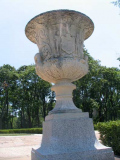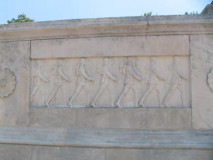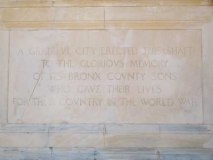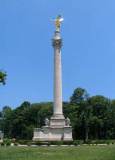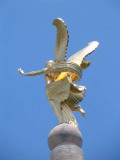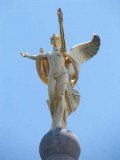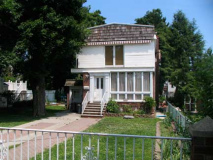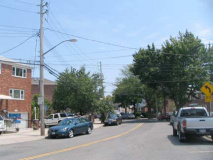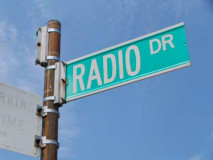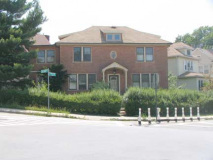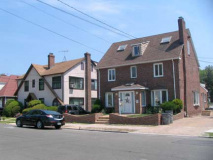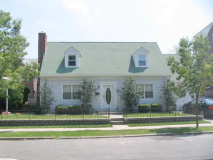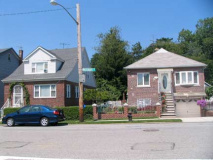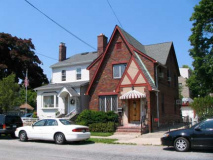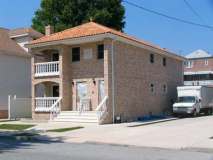Forgotten New York is sometimes like the NFL. (Stick with me.) The NFL is divided into two conferences, the AFC and the NFC, which in turn are divided into three divisions. Your team plays the teams in its own division twice per season, and it plays the rest against teams from your own conference and against a division from the other conference, which means your team sees a team from the other conference on average, once every 3 years. Because of scheduling quirks, though, you might not see a team from the other division or conference for 6 years or even nine.
Since your webmaster’s lair is in Little Neck, I see my own ‘division,’ which I consider northern Queens, downtown and mid-Manhattan, and northern Brooklyn, quite a bit…
…and I think of southern Brooklyn as well as mid-Queens and southern Queens out of division, but still in conference, i.e., I see them now and then, but not as often as the neighborhoods in my own division. Bronx, northern Manhattan and Staten Island, though, are in the other conference — I see their neighborhoods not as often as that, and sometimes very rarely indeed. Today’s explorations, in Pelham Bay, were definitely ‘out of conference’ since the last time I walked around in Middletown and Pelham Bay in the Bronx must have been 7 or 8 years ago. Fortunately, nothing around here seems to change much from year to year, except, of course, for encroaching bad architecture….
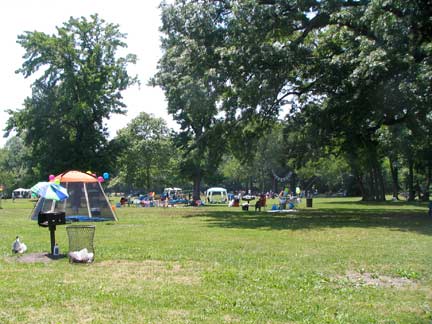
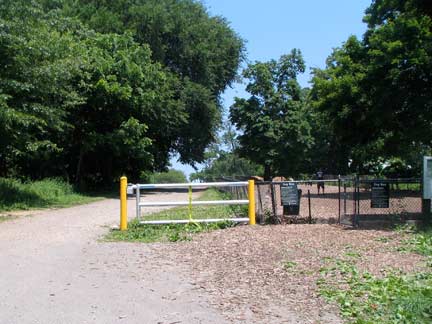
Most New Yorkers would likely immediately respond “Central Park” when asked what the larget park in New York City by acreage is. There are, however, several parks in NYC much larger than Central Park. Both Van Cortlandt Park and Pelham Bay Park, in the Bronx’ northeast corner, are over double Central Park’s size.
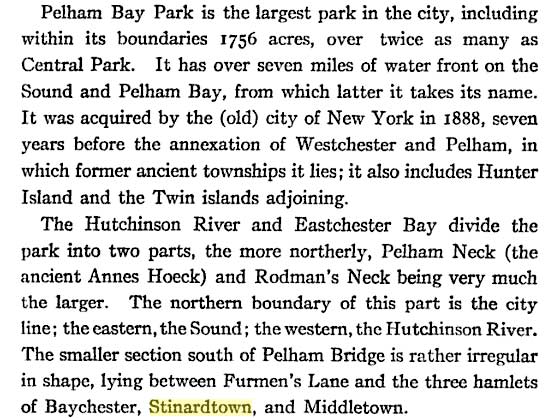
I screengrabbed some text from Stephen Jenkins’ 1912 The Story of the Bronx.
The park comes in two parcels, with the public park between the Bruckner Expressway to the west, Eastchester Bay to the east, and Shore Road to the north. A much larger section is found north of the Hutchinson River, consisting of the Pelham Bay and Split Rock golf courses. In this section you’ll also find historic artifacts such as Split Rock and Glover’s Rock, as well as Orchard Beach and the Bartow- Pell Mansion.
After taking a ride from Flushing on the QBx1 bus, which is a direct connection between Flushing and Pelham Bay, I walked around the park for a short time, observing that there apparently used to be a bridle path that is no longer used (photo above right). The true Pelham Bay Park attraction for decades, though, has been…
WAYFARING: PELHAM BAY/MIDDLETOWN
Bronx Victory Memorial
On the south side, decorative limestone urns and terra-cotta pots flank a broad central staircase. At the terrace level, Cordova cream limestone reliefs, designed by Kinney and Scholz, depict regiments of soldiers marching into battle. Most striking is their “Lady of Victory” poised atop a stone globe at the apex of the 70-foot high column. Measuring 18 feet in height and weighing 7,300 pounds, the sculpture and the classical column are part of a long symbolic sculptural tradition dating to Greek and Roman antiquity.
Council Member Madeline Provenzano sponsored a $1.1 million capital project, which in 2001, completed the first phase of restoring the Bronx Victory Memorial. The renovation consisted of extensive cleaning, repair, and replacement of the limestone masonry and ornamentation. The missing eagleís head was recarved as was the massive globe supporting the statue. The bronze sculpture was removed from her perch, repaired, regilded, and installed on the new globe. During the course of reconstruction, a time capsule was unearthed that will be reinstalled with new mementos in a second phase of work including plaza and landscape improvements. On November 11, 2001, at 11 a.m., exactly 83 years after the Armistice that ended World War I, the restored monument was rededicated. NYC Parks
The Bronx Victory Memorial is perhaps the grandest war memorial in NYC outside the Soldiers and Sailors Memorial Arch in Grand Army Plaza in Brooklyn, but few other than locals residents know about it since it is tucked away in Pelham Bay Park, facing the connecting road between the Bruckner Expressway and Shore Road.
The Bronx Victory Memorial was designed by architect and landscape architect John J. Sheridan (1888-1954), and sculptors Belle Kinney (1887-1959) and Leopold Scholz (1877-1946). It consists of a landscaped plaza and a raised paved terrace in which stands a massive limestone pedestal with sculptural reliefs. At the center of the pedestal, a Corinthian column is surmounted by a gilded bronze victory figure. Erected in 1932 and dedicated in 1933, the memorial and adjacent grove of trees on the south side of Shore Road commemorate the 947 soldiers from the Bronx who gave their lives in service during World War I.
…Plans were submitted for the war memorial by Bronx Parks Commissioner Thomas J. Dolen to the New York City Art Commission in the spring of 1930. The original proposed site – south of Pelham Parkway and west of Baychester Avenue – was modified, to avoid both removing memorial trees and having a screen of buildings as a backdrop.
Rice Stadium
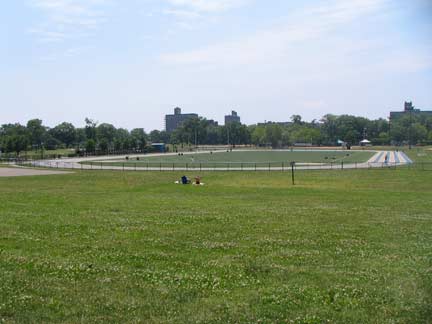
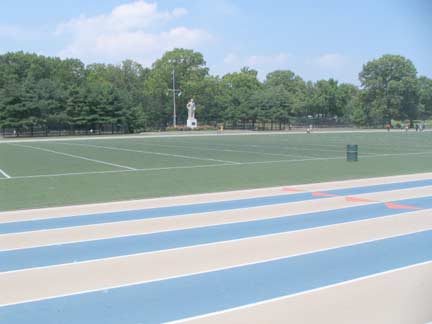
I had heard of Pelham Bay Park’s Rice Stadium on Middletown Road facing Kennilworth Place, constructed in the early 1920s and demolished in 1989. It was built with the aid of a $1M grant from Julia Rice, the widow of musician, lawyer, publisher, chess expert, submarine pioneer, and president of the Electric Storage Battery Company Isaac Leopold Rice. (Mrs. Rice was no slouch herself — she was the founder of The Society For the Suppression of Unnecessary Noise and organizer for Sane and Safe Fourth of July.) After years of deferred maintenance (where have we heard that tune before) the city deemed it necessary to demolish the stadium; it was replaced by the Aileen B. Ryan Recreational Complex, named for a local assemblywoman.
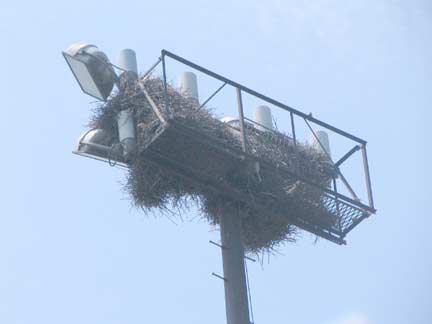
A familiar screech prompted me to look up and note the quaker parrot nests in the tall light stanchions.
American Boy
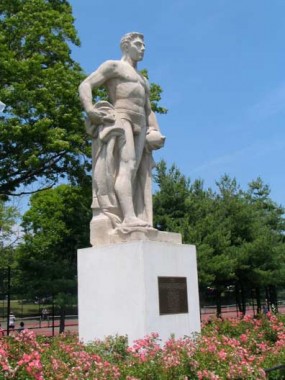
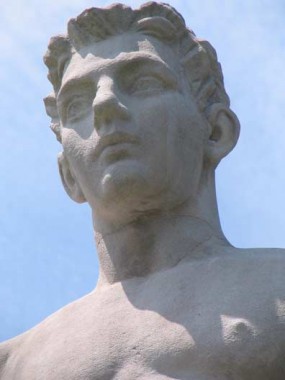
Does any trace remain of old Rice Stadium? Yes. The Louis St. Lannes limestone statue American Boy, installed in the Rice Stadium grandstand in 1932, was retained by the Parks Department, restored in 2002 and reinstalled in 2004.
Though ushered into the world with fanfare, the monument suffered over time from faulty construction, environmental erosion, and vandalism. In 1943, Parks crews conducted a large structural restoration. Numerous graffiti removals and paint-overs took their toll on the surface of the masonry blocks, ornamental details, and sculptural reliefs. The gold leaf disappeared altogether from Victory, leaving her bronze surface exposed to the elements. A crack in the supporting globe represented a potential safety hazard.
To restore the statue, Parks & Recreation cleaned the aging limestone surface, repaired structural problems, and reattached the statue’s head. Following the restoration, American Boy was carefully hoisted and transported to its new location in between Pelham Bay Park’s tennis courts and running track. The colossal sculpture now sits atop a new pedestal surrounded by pipe rail fencing, shrubs, and grass-filled terracing. A commemorative bronze plaque explains how the sculpture was intended to reflect an ideal of youth, and contains the original plaque’s inscription. NYC Parks
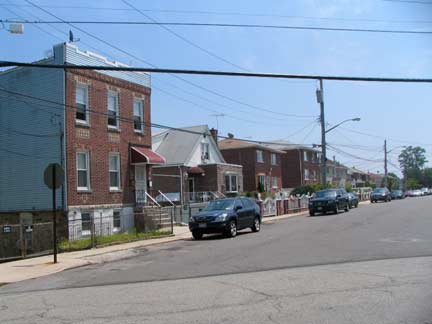
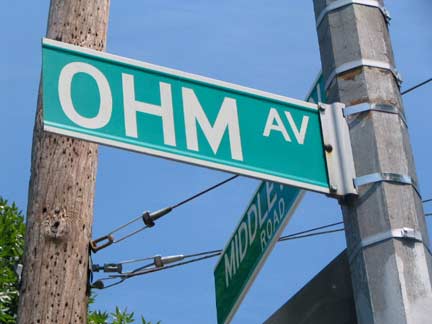
Streets in the vicinity of Rice Stadium were laid out in the early 1920s, about the time the stadium was constructed, and many have names honoring physicists such as Ohm, Ampere, Watt, as well as Radio, Research and Library. Recall that Isaac L. Rice was president of the Electric Storage Battery Company.
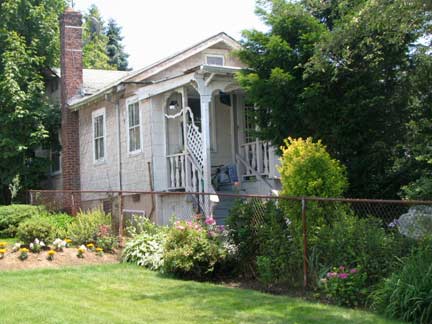

The neighborhoods immediately south of Pelham Bay Park are called Spencer Estates and further south, Country Club. In the 19th Century the Spencer family married into the tobacco-growing Lorillard family. William Spencer was a benefactor of the NY Public Library and son Lorillard Spencer was the publisher of The Illustrated American.
Along Stadium Avenue (named for Rice Stadium) are some older houses going back to the area’s development in the 1920s.
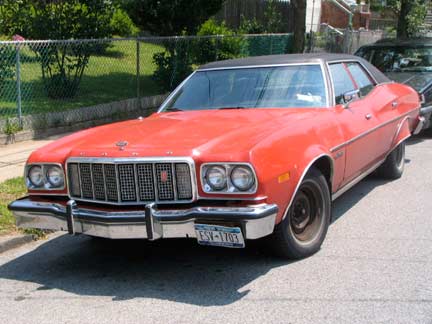
Clint Eastwood’s Walt Kowalski character might have been proud of the Gran Torino parked on Stadium Avenue, if hubcaps could be added.
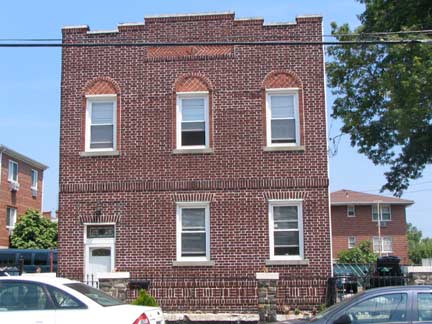
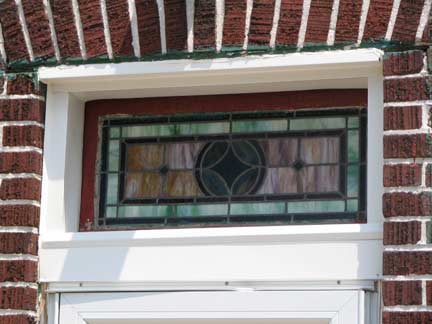
If a particular style of architecture can be called typical of an area, the style that dominates in Pelham Bay and Middletown is this modest, two story brick style. Here and there are touches like stained glass. The dwellings were likely originally built for two families.
Country Club
Now and then one of the smaller houses is set back far from the street behind a lengthy lawn.
The Bronx has nothing like Beverly Hills’ world-famous Rodeo Drive. But it does have the curving Radio Drive, another of the streets honoring Isaac Leopold Rice.
As you walk south on Stadium Avenue and encounter Country Club Road, there’s a subtle shift as the houses and plots become somewhat larger and more upscale. The residences here are built o what was once the Westchester County Country Club, which occupied 26 acres. Before that, the terriory was occupied by the Ferrises and Van Antwerps in the colonial era. The former North Road divided the Lorillard and Spencer estates.
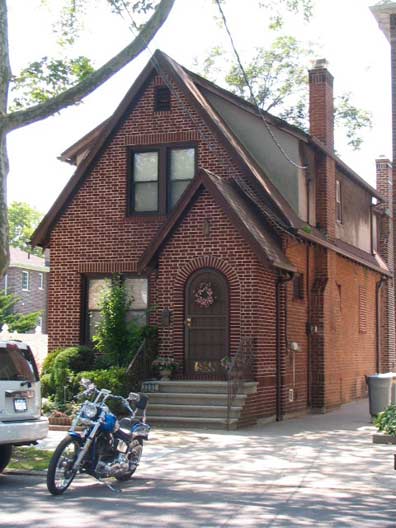
Though many houses and plots are large in Country Club, this small brick cottage on Campbell Drive captured my attention.

In this part of town, water views are for private home owners, not for the public, but I did catch a glimpse here at Agar Place and Country Club Drive.

Returning to Stadium Avenue I liked this 3-story white building with a set-back third floor, arched doorway and window. In the days before air conditioning, buildings used shade and awnings to keep out the heat (look at any 19th Century picture of NYC brownstone buildings and you can spot that right away). This building’s owners, perhaps, are reactivating the practice.
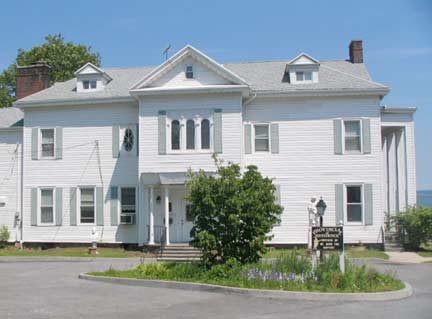
The Sisters of St. Joseph run a large nursing home called Providence Rest at Stadium Avenue and Waterbury Avenue. This is likely one of the older buildings, with a water view.
I turned right on Waterbury, and took a look at the well-cared for homes, some Tudor, on small but grassy plots.
However, the architectural rot of the late 20th and early 21st Century — cheaply made housing with prefab elements and concrete lawns, has begun to encroach. At least this one doesn’t have a garage occupying the first floor as many do.
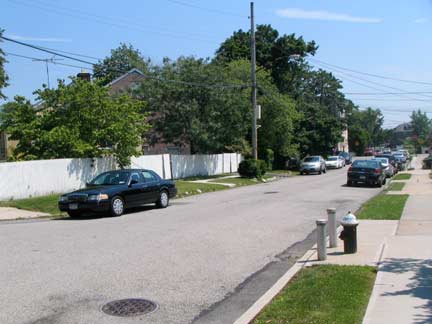
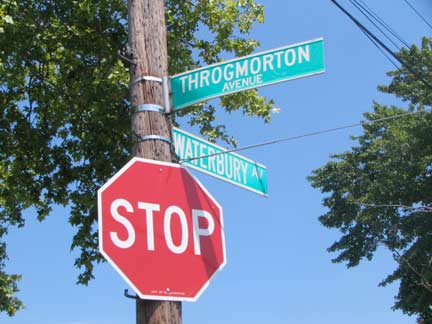
One of the quiet side streets is called Throgmorton Avenue, so named in 1916 to honor the founder of the Throg(g)s Neck community, John Throckmorton, a Britisher given permission by the Dutch government then in charge to settle on the southeastern end of what would become the Bronx in 1642. The name became altered in spelling over the years (I’ve even seen “Frog’s Neck” on some documents) and though the name is spelled Throgs Neck on maps and highway signage, most residents add an extra G so it becomes Throggs Neck.
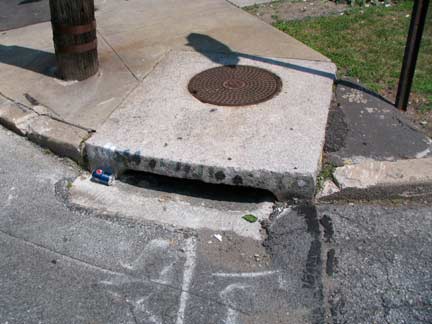
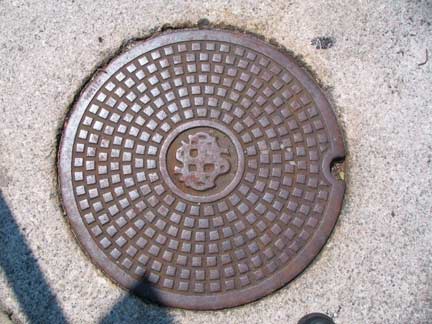
Scattered all around town are some very old sewer coverings and openings, accompanied by manholes marked with the initials of the former water companies and utilities that served them. I can’t make out the initials on this cover, can you?


